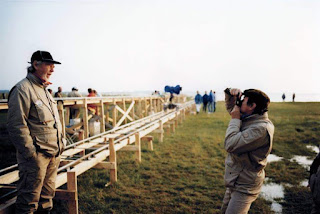Woman in the Dunes (1964, Hiroshi Teshigahara)
From the impeccably staged credit sequence and the very initial moments of a wanderer roaming in the sand dunes, Teshigahara makes us succumb to his idiosyncratic, muffling and precipitating world, a place inerrancy with absurd insects and ambiguous characters.
There's a sense of eerieness lurking throughout the movie, which isn't merely present to haunt or induce anxiety, rather than to get lost into the labyrinth of desires of the characters/creatures surrounding the protagonist. Teshigahara in full flow manages to juxtapose his ideology with titillation to arouse a sense of life's extreme vacuity.
The ubiquitous dunes abruptly moving and striding is as poetic a cinema can get, and with excessive closeup shots, one can feel the sweat strolling down one's torso in what is a profound parable, a combination of an existential writer and an avant-garde filmmaker.
Teshigahara's framing reminded me of Ozu, while the latter emphasised on stagnant and calm shots and had the proficiency to illustrate his subjects with utmost simplicity, the former is more chaotic in his choices but still, there's a clump of composure present within its madness.
Eroticism finds the topmost place in Teshigahara's classic and is palpable throughout the film. Each scene elicits lust and affection, be it the energetic erotic scenes between the primary characters or the distinct creatures meandering, all culminates concurrently to become a sexually charged drama descending into infatuation, providing a sensual exploration of the human condition.
The film is as horrific and terrifying as it is lyrical and political, as we get to witness a circus-like scene when a horde gathers to get the couple put on an intimate scene. The blend of numerous high pitched sounds made it an unsettling watch, as Teshigahara paints a portrait of commoners getting bamboozled by power mongers.
Woman in the Dunes remains one of the most striking and unnerving achievements from the Japanese New Wave.







Comments
Post a Comment